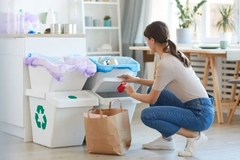Regulatory cacophony? Fresh produce association warns of EU food safety pitfalls in PPWR proposal
13 May 2024 --- The European Parliament’s (EP) vote on the EU’s Packaging and Packaging Waste Regulation (PPWR) is threatening fresh food safety and standardized regulations throughout the bloc, according to the chief science officer at the International Fresh Produce Association (IFPA).
The EP voted at the end of April that certain single-use plastic packaging types will be banned from January 1, 2030, including solutions for unprocessed fresh fruit and vegetables, F&B filled and consumed in cafés and restaurants and individual portions such as condiments, sauces, creamer and sugar.
We sit down with Dr. Max Teplitski to discuss the potential effect of the EP’s vote on PPWR and what the association expects from the Council, to address food safety and minimize waste.
What can you tell us about the EP’s PPWR vote and its effect on single-use plastic packaging?
Teplitski: We are disappointed that the EP chose to deprioritize consumer safety, took a narrow view of carbon footprint and opened the very real possibility that each EU member will craft their own policies on food safety and packaging.
While for some things, packaging is a convenience factor, for fresh and ready-to-eat products, packaging is an absolute necessity to prevent spoilage, cross-contamination, intentional or unintentional introduction of pathogens or allergens. By banning single-use packaging for pre-made salads or ready-to-eat greens, for example, lawmakers are about to set a continent-wide food safety experiment with unknown outcomes in motion.
 Preventing cross-contamination of ready-to-eat products will be challenging without single-use packaging, says Teplitski.What is the association’s position on the new rules?
Preventing cross-contamination of ready-to-eat products will be challenging without single-use packaging, says Teplitski.What is the association’s position on the new rules?
Teplitski: Study after study demonstrates that single-use packaging is critical to maintaining freshness and food safety of ready-to-eat fresh products. Packaging keeps fruits and vegetables fresh for up to two weeks without using harsh chemicals — decades of engineering research led to these marvels that we, consumers, take for granted.
The result of these bans is more food waste and large-scale outbreaks of foodborne illness. We were absolutely shocked to see that even compostable packaging is effectively banned. The EP left essentially no tools for the industry to honor our promise to consumers to deliver the freshest food safely.
If adopted by the Council, what could the new rules mean for the packaging industry?
Teplitski: If the Council doesn’t act, PPWR as voted on by the EP, will create a cacophony of local regulations on food safety exemptions and compostable packaging. Trading partners, including within the EU, will have to think twice about how they package fresh produce and — with shortened shelf consideration in mind — will likely opt out. Preventing cross-contamination (intentional or not) of unpackaged ready-to-eat products will be challenging.
Without packaging, ready-to-eat greens, pre-made salads, pre-cut fruits and vegetables will either entirely disappear or will be reduced in the diversity of offerings. Collectively, this will impact the consumers — fewer healthy options will be on the shelves and the elderly and disabled who rely on pre-cut or pre-made healthy food options will not have access to them.
Data from states like New Jersey — where single-use plastics were banned — suggests that the use of plastics tripled because lighter-weight single-use plastics were replaced with more durable ones that linger in the environment for much longer.
What are the association’s recommendations to policymakers to improve PPWR rules?
Teplitski: We ask that the Council members focus on consumers — food safety, food quality and price. It is also important to maintain one EU market. Therefore, it is critical to reinstate the food safety exemption for fresh and fresh-cut produce that was in one of the earlier drafts of PPWR and commit to providing access to safe food EU-wide.
The Council needs to unequivocally support alternatives — compostable packaging needs to be available to consumers EU-wide.
Price look-up sticky labels (PLU stickers) are an alternative to packaging altogether — they need to be available as an alternative to single-use packaging, and they convey critical information about food safety. In the future, they will allow the industry to tell consumers about the product’s carbon footprint.
By Natalie Schwertheim












